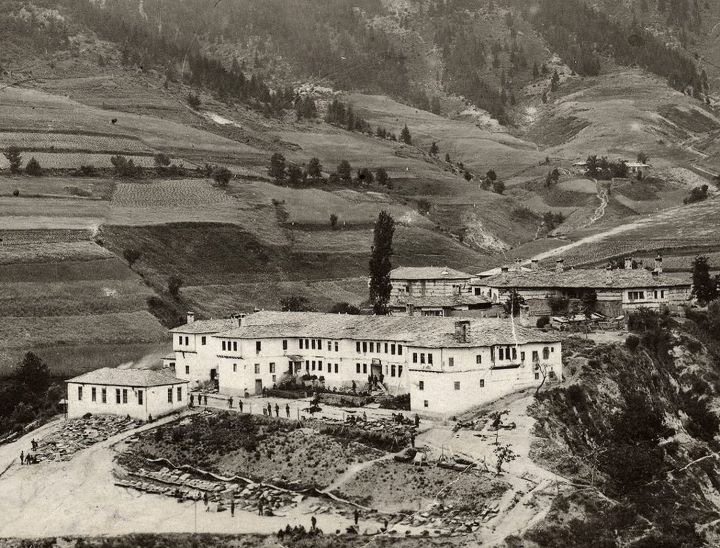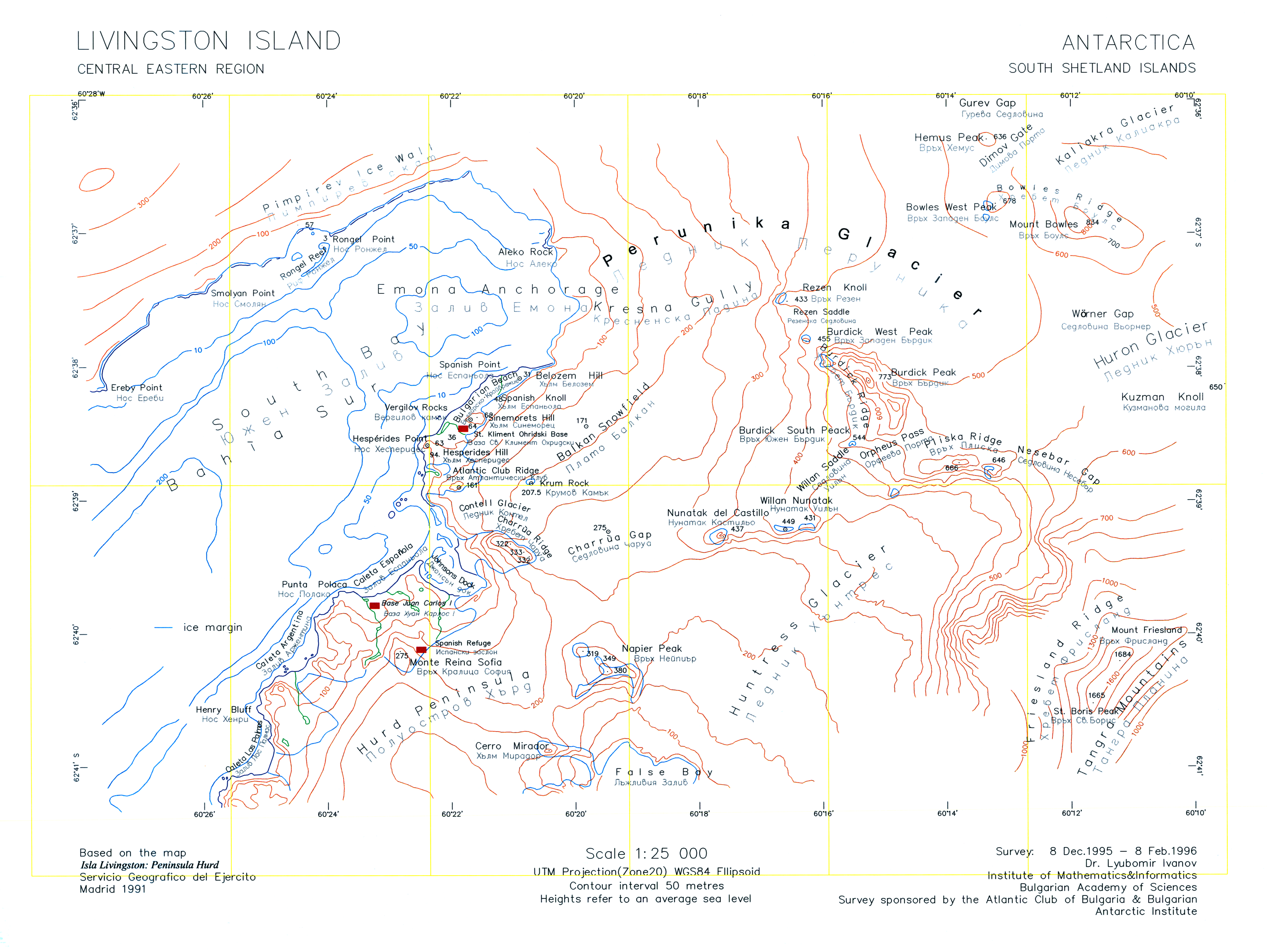|
Smolyan Point
Smolyan Point (Nos Smolyan \'nos 'smo-lyan\) is located on the north-western coast of South Bay, Livingston Island in the South Shetland Islands, Antarctica forming the northwest side of the entrance to Emona Anchorage. The ice-covered point shows conspicuous radial crevasses spreading inland and ends up with a 25 m wide and 4 m high rock. The feature was formed as a result of Pimpirev Glacier's retreat in the late 20th century. Smolyan is the name of a town in the Rhodope Mountains in southern Bulgaria. Location The point is located at , which is 1.86 km east-northeast of Ereby Point and 3.7 km northwest of Hespérides Point. (Bulgarian mapping in 1996, 2005 and 2009 from a 1995/96 Bulgarian topographic survey). Maps * L.L. Ivanov. Livingston Island: Central-Eastern Region. Scale 1:25000 topographic map. Sofia: Antarctic Place-names Commission of Bulgaria, 1996. * L.L. Ivanov et al. Antarctica: Livingston Island and Greenwich Island, South Shetland Islands. Scal ... [...More Info...] [...Related Items...] OR: [Wikipedia] [Google] [Baidu] |
Smolyan
Smolyan ( bg, Смолян) List of cities and towns in Bulgaria, is a town and ski resort in the south of Bulgaria near the border with Greece. It is the administrative and industrial centre of the homonymous Smolyan Province. The town is built along the valley of Cherna ("Black") and Byala River, Byala ("White") rivers in the central Rhodope Mountains which makes him the longest city in Bulgaria. It is also located at foot of the mountain's highest peak Golyam Perelik - 2191m. Smolyan is just 10-15 minutes drive from the popular ski resorts Pamporovo and Chepelare. As of June 2022 it has a population of 30 689 inhabitants. Name The name of the town comes from the local Slavic tribe of the Smolyani, the name of whom is probably cognate to the Slavic word ''smola'' ("resin"). History According to archaeological evidence, the area around Smolyan was first settled in the 2nd millennium BC, 2nd-1st millennium BC. In the Middle Ages it acquired its name from the Slavic peoples, Sla ... [...More Info...] [...Related Items...] OR: [Wikipedia] [Google] [Baidu] |
Composite Antarctic Gazetteer
The Composite Gazetteer of Antarctica (CGA) of the Scientific Committee on Antarctic Research (SCAR) is the authoritative international gazetteer containing all Antarctic toponyms published in national gazetteers, plus basic information about those names and the relevant geographical features. The Gazetteer includes also parts of the International Hydrographic Organization (IHO) General Bathymetric Chart of the Oceans (GEBCO) gazetteer for under-sea features situated south of 60° south latitude. , the overall content of the CGA amounts to 37,893 geographic names for 19,803 features including some 500 features with two or more entirely different names, contributed by the following sources: {, class="wikitable sortable" ! Country ! Names , - , United States , 13,192 , - , United Kingdom , 5,040 , - , Russia , 4,808 , - , New Zealand , 2,597 , - , Australia , 2,551 , - , Argentina , 2,545 , - , Chile , 1,866 , - , Norway , 1,706 , - , Bulgaria , 1,450 , - , G ... [...More Info...] [...Related Items...] OR: [Wikipedia] [Google] [Baidu] |
Hespérides Point
Hespérides Point ( es, Punta Hespérides) is a rocky point of land projecting into South Bay north-northwest of Johnsons Dock, Livingston Island in the South Shetland Islands, Antarctica and forming the southwest side of the entrance to Emona Anchorage. Surmounted by Hesperides Hill. The area was visited by 19th century sealers operating from nearby Johnsons Dock. The feature is named after the Spanish ocean exploration ship BIO Hesperides. Location The point is located at which is 12.36 km east-northeast of Hannah Point, 3.7 km southeast of Smolyan Point and 1.59 km north of Ballester Point Ballester Point ( bg, text=нос Балестер, italic=no, ‘Nos Ballester’ \'nos ba-'les-ter\) is a point forming the south side of the entrance to Johnsons Dock and the northeast side of the entrance to Española Cove in Hurd Peninsula, ... (British mapping in 1968, detailed Spanish mapping in 1991 and Bulgarian mapping in 1996, 2005 and 2009). Maps * Isl ... [...More Info...] [...Related Items...] OR: [Wikipedia] [Google] [Baidu] |
Ereby Point
Ereby Point () is a point lying east-northeast of Hannah Point along the north side of South Bay, Livingston Island in the South Shetland Islands, Antarctica. The name "Erebys Bay" was applied to South Bay on an 1825 chart by James Weddell, "Ereby Point" was applied by the UK Antarctic Place-names Committee The UK Antarctic Place-Names Committee (or UK-APC) is a United Kingdom government committee, part of the Foreign and Commonwealth Office, responsible for recommending names of geographical locations within the British Antarctic Territory (BAT) and ... in 1961 in order to preserve Weddell's name in the area. Maps * L.L. Ivanov et al. Antarctica: Livingston Island and Greenwich Island, South Shetland Islands. Scale 1:100000 topographic map. Sofia: Antarctic Place-names Commission of Bulgaria, 2005. * L.L. IvanovAntarctica: Livingston Island and Greenwich, Robert, Snow and Smith Islands Scale 1:120000 topographic map. Troyan: Manfred Wörner Foundation, 2009. Antarctic Dig ... [...More Info...] [...Related Items...] OR: [Wikipedia] [Google] [Baidu] |
Bulgaria
Bulgaria (; bg, България, Bǎlgariya), officially the Republic of Bulgaria,, ) is a country in Southeast Europe. It is situated on the eastern flank of the Balkans, and is bordered by Romania to the north, Serbia and North Macedonia to the west, Greece and Turkey to the south, and the Black Sea to the east. Bulgaria covers a territory of , and is the sixteenth-largest country in Europe. Sofia is the nation's capital and largest city; other major cities are Plovdiv, Varna and Burgas. One of the earliest societies in the lands of modern-day Bulgaria was the Neolithic Karanovo culture, which dates back to 6,500 BC. In the 6th to 3rd century BC the region was a battleground for ancient Thracians, Persians, Celts and Macedonians; stability came when the Roman Empire conquered the region in AD 45. After the Roman state splintered, tribal invasions in the region resumed. Around the 6th century, these territories were settled by the early Slavs. The Bulgars, led by Asp ... [...More Info...] [...Related Items...] OR: [Wikipedia] [Google] [Baidu] |
Rhodope Mountains
The Rhodopes (; bg, Родопи, ; el, Ροδόπη, ''Rodopi''; tr, Rodoplar) are a mountain range in Southeastern Europe, and the largest by area in Bulgaria, with over 83% of its area in the southern part of the country and the remainder in Greece. Golyam Perelik is its highest peak at . The mountain range gives its name to the terrestrial ecoregion Rodope montane mixed forests that belongs in the temperate broadleaf and mixed forests biome and the Palearctic realm. The region is particularly notable for its karst areas with their deep river gorges, large caves and specific sculptured forms, such as the Trigrad Gorge. A significant part of Bulgaria's hydropower resources are located in the western areas of the range. There are a number of hydro-cascades and dams used for electricity production, irrigation, and as tourist destinations. In Greece, there are also the hydroelectric power plants of Thisavros and Platanovrysi. The Rhodopes have a rich cultural heritage including a ... [...More Info...] [...Related Items...] OR: [Wikipedia] [Google] [Baidu] |
Pimpirev Glacier
Pimpirev Glacier ( bg, Пимпирев ледник, Pimpirev lednik, ) on Livingston Island in the South Shetland Islands, Antarctica is situated south of the glacial divide between the Drake Passage and Bransfield Strait, southeast of Tundzha Glacier, southwest of Saedinenie Snowfield, west of Perunika Glacier and east-northeast of Kamchiya Glacier. The feature extends 5.5 km in a southeast-northwest direction, and 1.8 km in northwest-southeast direction. The glacier drains southeastwards towards Pimpirev Beach, mostly terminating on the shore, and on several occasions penetrating the South Bay waters east-northeast of Ereby Point. The feature is named for Christo Pimpirev, geologist in the First Bulgarian Antarctic Expedition in 1987/88 and leader of subsequent national Antarctic campaigns. The original name '' Pimpirev Ice Wall'' was given on October 29, 1996 to the 50-m high rectilinear ice scarp-slope running parallelly to and some 100 m inland from the coa ... [...More Info...] [...Related Items...] OR: [Wikipedia] [Google] [Baidu] |
Emona Anchorage
Emona Anchorage ( bg, залив Емона, zaliv Emona, ) is a roughly square embayment, the internal part of South Bay, Livingston Island in the South Shetland Islands, Antarctica used as an anchorage for ships visiting the Bulgarian base St. Kliment Ohridski. Emona is the name of a village and, in the version of Emine, a nearby cape on the Bulgarian Black Sea Coast. Location The feature is centred at . Details Entered between Hespérides Point and Smolyan Point, the bay is over 100 m deep at its central portion northwest by north of Spanish Point. Northeast of Smolyan Point, a nameless 710 m wide cove is indenting for 250 m behind Rongel Reef, with a shoal east of that cape, and a small awash islet 550 m due northeast of it. Rongel Point forms the east-northeast side of that cove’s entrance. The remaining northwest coast of Emona Anchorage is, with several minor disruptions, a narrow beach under the ice-cap cliff, with Pimpirev Ice Wall, an ice form in Pimpirev Glac ... [...More Info...] [...Related Items...] OR: [Wikipedia] [Google] [Baidu] |







